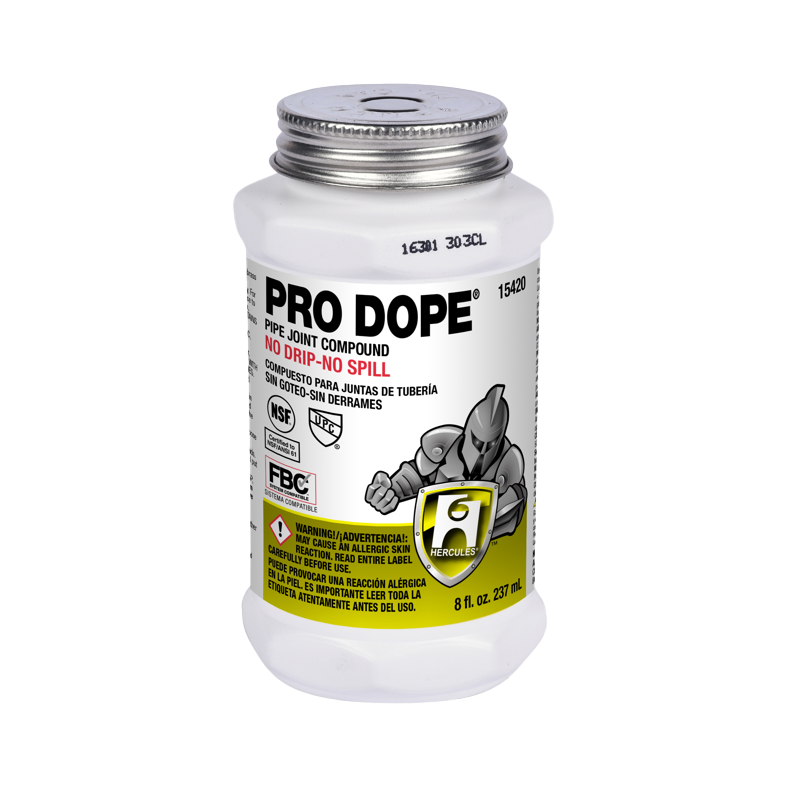When completing a plumbing project, determining the right thread sealant to use depends on a number of factors. Knowing what options are available, when to use them and how to apply them will help you achieve and maintain a watertight and airtight seal between pipes every time.
When to use a thread sealant
Almost all plumbing systems (such as a natural gas pipe, compressed air pipe or a shower head and beyond) will have a section where a threaded connection is required. Threaded pipe and fittings are considered male and female and most commonly contain NPT (National Pipe Tapered) threads. NPT means that the male and female threads are tapered when cut, allowing for easy alignment of the male threads at the start of the joint assembly. As the joints are tightened, the harder it becomes to turn. These joint assemblies cannot achieve a watertight/airtight seal on their own, so when assembling, an approved thread sealant is required to fill the remaining voids in the root of the threads to create a seal.
How to choose a thread sealant
What type of sealant should you choose? Thread sealants are available in either a tape or a pipe joint compound (often referred to as “pipe dope”). Each has benefits and features but knowing which one to choose and how to apply it to your pipe's surface will save you time and frustration.

- Thread Sealant Tape, such as Hercules® MegaTape, comes in a variety of colors, widths, thickness and densities.
- Colors are used as visual identifiers to show a person what is flowing through a piping system. For Instance, yellow thread sealant tape is required by most municipalities when assembling a gas piping system. General purpose tapes are usually white and are also available in grey, which make it more aesthetically pleasing when used on pipe materials that are similar in color.
- Widths include ½”, ¾”, and 1”. A ½” width tape would be ideal for smaller diameter pipe. When assembling larger diameter pipes a ¾” or 1” width would be best because it provides better coverage on the threaded section of the pipe.
- Thickness is usually referred to by mil. Higher mil thickness reduces the number of full wraps necessary to create a water/airtight seal.
- Density refers to the pipe's ability to be compacted into the root of the threads. Tapes higher in density prevent excess stretching during assembly, which would lead to less compaction and possible leak paths.
- Pipe Joint Compound, such as Hercules® Megaloc® and Hercules® Pro Dope®, should be selected based on pipe and fitting material compatibility, chemical compatibility and temperature performance ranges. To determine pipe joint compound compatibility and temperature performance ranges, please refer to the submittal sheets located at www.oatey.com.
 Material Compatibility is important to know when assembling a threaded joint. For instance, if a joint compound is used on a non-compatible material it can cause the material to degrade rapidly and lead to a possible failure.
Material Compatibility is important to know when assembling a threaded joint. For instance, if a joint compound is used on a non-compatible material it can cause the material to degrade rapidly and lead to a possible failure. - Chemical Compatibility is another factor to consider when determining what pipe joint compound to use. The chemical composition of the pipe joint compound can be compromised if prolonged exposure to an incompatible chemical is introduced.
- Temperature performance range is the temperatures at which the pipe joint compound will function. Brushability temperatures and performance ranges must be determined prior to selecting a pipe joint compound especially if being utilized in systems with temperature extremes.
How to Apply Thread Sealant
 Whether you are applying a thread sealant tape or a pipe joint compound, you will always apply them to the male threads. Applying only to the male threads will reduce the possibility of blocking or restricting the inside of the pipe and fitting.
Whether you are applying a thread sealant tape or a pipe joint compound, you will always apply them to the male threads. Applying only to the male threads will reduce the possibility of blocking or restricting the inside of the pipe and fitting. - Tape and joint compound can be used in conjunction with one another. Once the male threads are correctly wrapped with thread tape, you can apply a coating of pipe joint compound over the thread sealant tape before assembling the joint. Due to pipe and fittings NPT tapered design, thread tape is designed to go directly on the male threads to ensure that as the joint is assembled, the tape will be compacted into the root of the thread. A thread tape’s elasticity allows it to stretch when applied and does not completely fill the root to crest of the thread. Applying joint compound on top of the tape will fill any remaining voids as the joint is assembled, and any excess joint compound will be pushed out of the fitting.
- Once you have selected the correct tape sealant for your application, you will wrap the tape 3-5 revolutions in a clockwise motion keeping the tape just above the last male thread of the pipe or fitting. Wrapping the pipe in the same direction that you would screw it into the fitting will prevent the tape from unraveling during assembly.
- When applying pipe joint compound remember that you are filling the thread openings, so applying the compound in the same direction as the threads will sometimes lead to poorly filled joints. Brushing across the threads will provide better coverage and will ensure that you will always fill the threads.